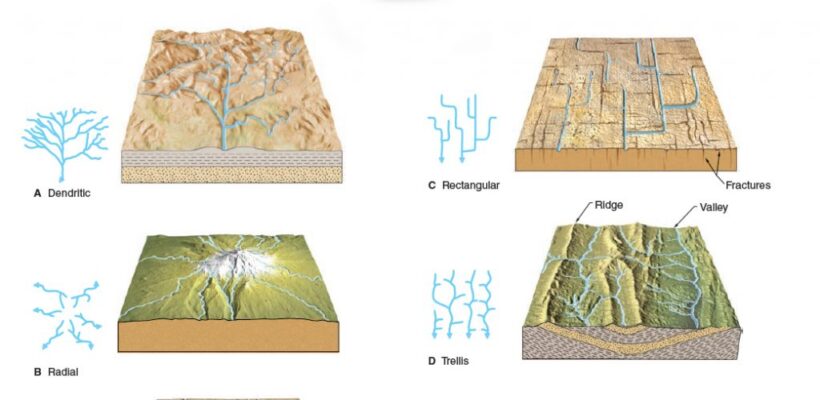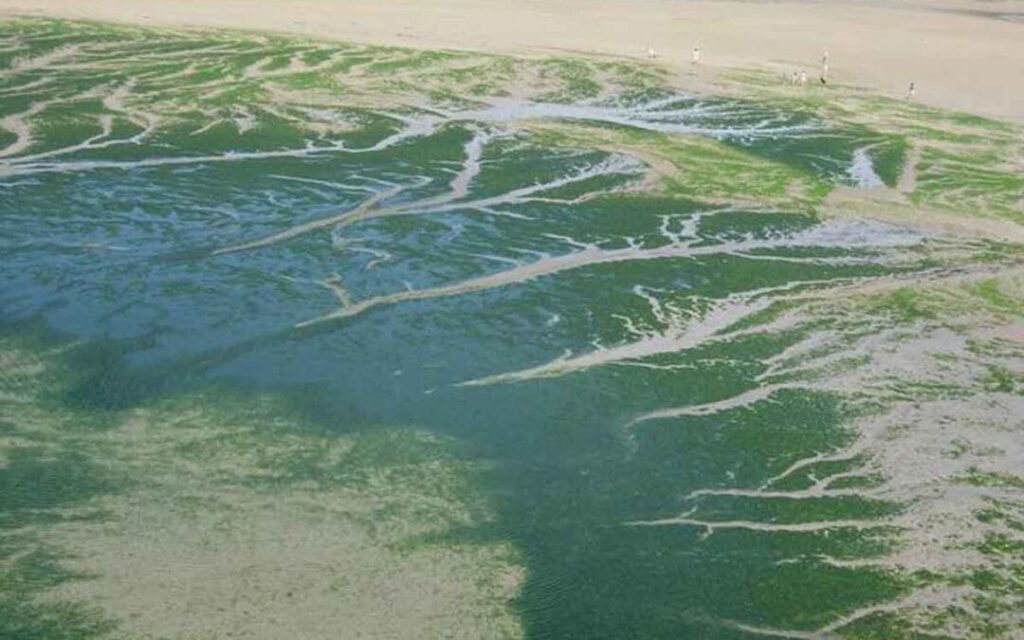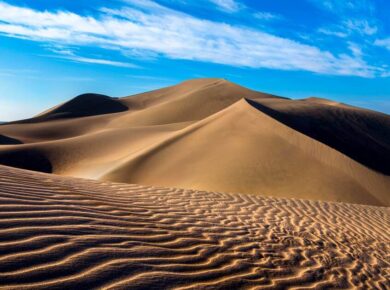River Drainage Patterns & Erosion Processes
River Drainage Patterns
Dendritic Drainage Patterns
- If the rocks are composed of homogeneous beds of uniform resistance to erosion, the tributaries will join the main stream obliquely as insequent streams
- The drainage pattern so evolved will be tree like in appearance & therefore termed as Dendritic drainage
- Most of the rivers of the Indo-Gangetic Plains are of dendritic type
Rectangular Drainage Pattern
- Rectangular drainage pattern is found in regions that have undergone faulting.
- Rectangular drainage develops on rocks that are of approximately uniform resistance to erosion, but which have two directions of jointing at approximately right angles.
- The joints are usually less resistant to erosion than the bulk rock, so erosion tends to open the joints and streams eventually develop along the joints.
- The result is a stream system in which streams consist mainly of straight-line segments with right angle bends and tributaries join larger streams at right angles.
- A typical example of this drainage pattern is found is the Vindhyan Mountains of India.
Trellis Drainage Pattern
- Trellis drainage develops in folded topography like that found in the Appalachian Mountains of North America.
- Rocks are made up of alternate layers of hard & soft rocks, hence tributaries tends to follow the pattern of rock structure
- A trellis drainage pattern occurs when tributaries join a main stream and erode a valley at approximately right angles in a pattern that resembles a garden trellis.
- The old folded mountains of the Singhbhum (Chotanagpur Plateau) have a drainage of trellis pattern
Radial Drainage Pattern
- It is a pattern characterized by outflowing rivers, away from a central point, analogous with the spokes of a wheel.
- It tends to develop on the flanks of a dome or a volcanic cone.
- A good example of a radial drainage pattern is provided by the rivers originating from the Amarkantak Mountain.
- Rivers like Narmada, Son and Mahanadi originating from Amarkantak Hills flow in different directions and are good examples of radial pattern.
- Radial drainage patterns are also found/in the Girnar Hills (Kathiawar, Gujarat), and Mikir Hills of Assam
Processes of river action
- When a river flows it carries with it eroded materials which can be divided into 3 distinct types
| Materials in Solution | Minerals which are dissolved in water |
| Materials in Suspension | Suspension of Sand, Silt & Mud in water |
| The Traction Load | Coarser materials such as pebbles, stones, rocks & Boulders |
- The ability of river to move the various grades of materials depends greatly on the volume of the water, velocity of the flow & size, shape and weight of the load
- It is said that by doubling the velocity of a river, its transporting power is increased by more than 10 times.
River Erosion & Transportation Processes
Corrasion / Abrasion
- Mechanical grinding of river’s traction load against the banks & bed of the river.
- The rock fragments hurdle against the sides as well as bottom of the river leading to lateral & vertical corrasion
- Lateral corrasion is sideways erosion which widens the V shaped valley.
- Vertical corrasion is the downward action which deepens the river channel.
Corrosion / Solution
- Chemical action of water on soluble or partly soluble rocks with which river come into contact
- For ex. in case of Calcium carbonate
Hydraulic Action
- Mechanical loosening & sweeping away of materials by river water
- Mainly by surging into the crevices & cracks of rocks & disintegrating them
Attrition
- Wear & tear of transported material among them when they roll and collide into one another.
For more updates, explore the Geography . Feel free to share your thoughts and comments.
If you’re passionate about building a successful blogging website, check out this helpful guide at Coding Tag – How to Start a Successful Blog. It offers practical steps and expert tips to kickstart your blogging journey!





1 comment
+parallel drainage system
+annular drainage system
+angular drainage system